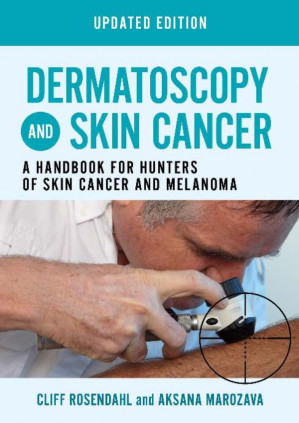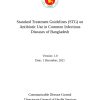Dermatoscopy and Skin Cancer updated edition: A handbook for hunters of skin cancer and melanoma by Cliff Rosendahl, Aksana Marozava ISBN 1911510339 9781911510338
$50.00 Original price was: $50.00.$25.00Current price is: $25.00.
Instant download Dermatoscopy and Skin Cancer updated edition: A handbook for hunters of skin cancer and melanoma after payment ISBN: 1911510339 9781911510338

Product detail:
- ISBN-10 : 1911510339
- ISBN-13 : 978-1911510338
- Author: Cliff Rosendahl, Aksana Marozava
Dermatoscopy and Skin Cancer , updated edition, is a handbook to help dermatologists, dermatoscopists and GPs easily differentiate between benign and malignant tumours, leading to fewer unnecessary biopsies and earlier treatment of cancers.
Based around two easy to follow algorithms, ‘Chaos and Clues’ and ‘Prediction without Pigment’ , the book shows all dermatoscope users how to confidently diagnose skin lesions earlier and with greater precision.
In addition, this handbook provides coverage of:
the microanatomy of the skin
specimen processing and histopathology
the language of dermatoscopy to help name and define structures and patterns
approaches to skin examination and photodocumentation
revised pattern analysis as an additional diagnostic algorithm
dermatoscopic features of common and significant lesions.
Using hundreds of high quality images, the authors provide a detailed algorithmic approach to assessing the skin; an approach that has been successfully taught to thousands of doctors around the world.
Table of contents
Chapter 1
Introduction to dermatoscopy
1.1. Why use a dermatoscope?
1.1.1. The economic impact of dermatoscopy
1.2. What is a dermatoscope
1.3. Colours in dermatoscopy
1.4. Differences between polarised and non-polarised dermatoscopy
1.5. Uses of dermatoscopy for conditions other than tumours
1.5.1. Dermatoscopy of perilesional skin
1.5.2. Dermatoscopy of inflammatory conditions and dermatoses
1.5.3. Dermatoscopy of hair
1.5.4. Dermatoscopy of skin infestations and infections
1.5.5. Dermatoscopy of nails
References
Chapter 2
Skin – the organ
2.1. Skin as an organ
2.2. Embryology of skin
2.3. The microanatomy of skin
2.3.1. Epidermis
2.3.2. Melanin production
2.3.3. Skin phototypes
2.3.4. Melanocytic vs melanotic
2.3.5. Why does melanin appear as different colours at different depths in the skin?
2.3.6. Epidermal appendages
2.3.7. The basement membrane
2.3.8. The dermis
2.3.9. Skin blood supply
2.3.10. Skin lymphatics
2.3.11. Skin innervation
2.3.12. Anatomy of volar skin
2.3.13. Anatomy of the nail apparatus
2.3.14. Anatomy of the eye in relation to melanocytic neoplasia
References
Chapter 3
Dermatopathology for dermatoscopists
3.1. From the scalpel to the microscope
3.1.1. Specimen processing workflow
3.2. The histology of normal skin
3.3. Terminology used in dermatopathology
3.4. Dermatoscopic histological correlation of neoplastic lesions
3.4.1. The assessment of lesions
3.4.2. Histology of melanoma
3.4.3. Histology of basal cell carcinoma
3.4.4. Histology of common benign keratinocytic lesions
3.4.5. Histology of squamous cell carcinoma
References
Chapter 4
The language of dermatoscopy: naming and defining structures and patterns
4.1. The evolution of metaphoric terminology for dermatoscopic structures and patterns
4.1.1. Structures in revised pattern analysis
4.2. Revised pattern analysis of lesions pigmented by melanin
4.2.1. Basic structures
4.2.2. Lines
4.2.3. Circles
4.2.4. Clods
4.2.5. Structureless
4.3. Patterns in revised pattern analysis
4.3.1. Why the 2-step method of dermatoscopy is not used in revised pattern analysis
4.4. The process of revised pattern analysis
4.5. Revised pattern analysis applied to lesions with white structures
4.5.1. White lines
4.5.2. White clods (including white dots)
4.5.3. White structureless areas in flat lesions
4.5.4. White circles in flat lesions
4.5.5. White keratin clues in raised lesions
4.6. Revised pattern analysis applied to lesions with orange, yellow and skin-coloured structures
4.7. Revised pattern analysis applied to vessel structures and patterns
4.7.1. Vessel structures
4.7.2. Vessel patterns
4.7.3. The anatomical correlation of vessel structures and patterns
4.8. The cognition of dermatoscopy
References
Chapter 5
The skin examination
5.1. The skin check consultation
5.1.1. Who needs a full skin examination?
5.1.2. History taking
5.1.3. The skin examination
5.1.4. Clinical examination
5.1.5. Dermatoscopic examination
5.1.6. A methodical approach to complete skin examination
5.2. Photo-documentation
5.2.1. Workflow for photo-documentation
5.3. Patient safety: tracking specimens and self-audit
5.4. The lives of lesions
References
Chapter 6
‘Chaos and Clues’ (Chaos, Clues and Exceptions): a decision algorithm for pigmented skin lesions
6.1. ‘Chaos and Clues’
6.2. Chaos
6.3. Clues
6.3.1. Grey or blue colour
6.3.2. Structureless eccentric area
6.3.3. Clods black peripheral
6.3.4. Lines thick reticular
6.3.5. Lines radial segmental
6.3.6. Lines white
6.3.7. Lines angulated
6.3.8. Lines parallel on the ridges (volar) or lines parallel chaotic on the nails
6.3.9. Vessels polymorphic
6.4. Exceptions
6.4.1. Any changing lesion on an adult
6.4.2. A nodular or small lesion which has any of the clues to malignancy
6.4.3. Any lesion on the head or neck with pigmented circles and/or any dermatoscopic grey
6.4.4. Any lesion on volar skin (palms or soles) with a parallel ridge pattern
6.5.
People also search
dermatoscopy and skin cance
dermatoscopy and skin cancer pdf
dermatoscopy and skin cancer updated edition
does cancer cause skin changes
how does cancer affect skin
can cancer cause skin problems
can skin cancer lead to other cancers




Reviews
There are no reviews yet.